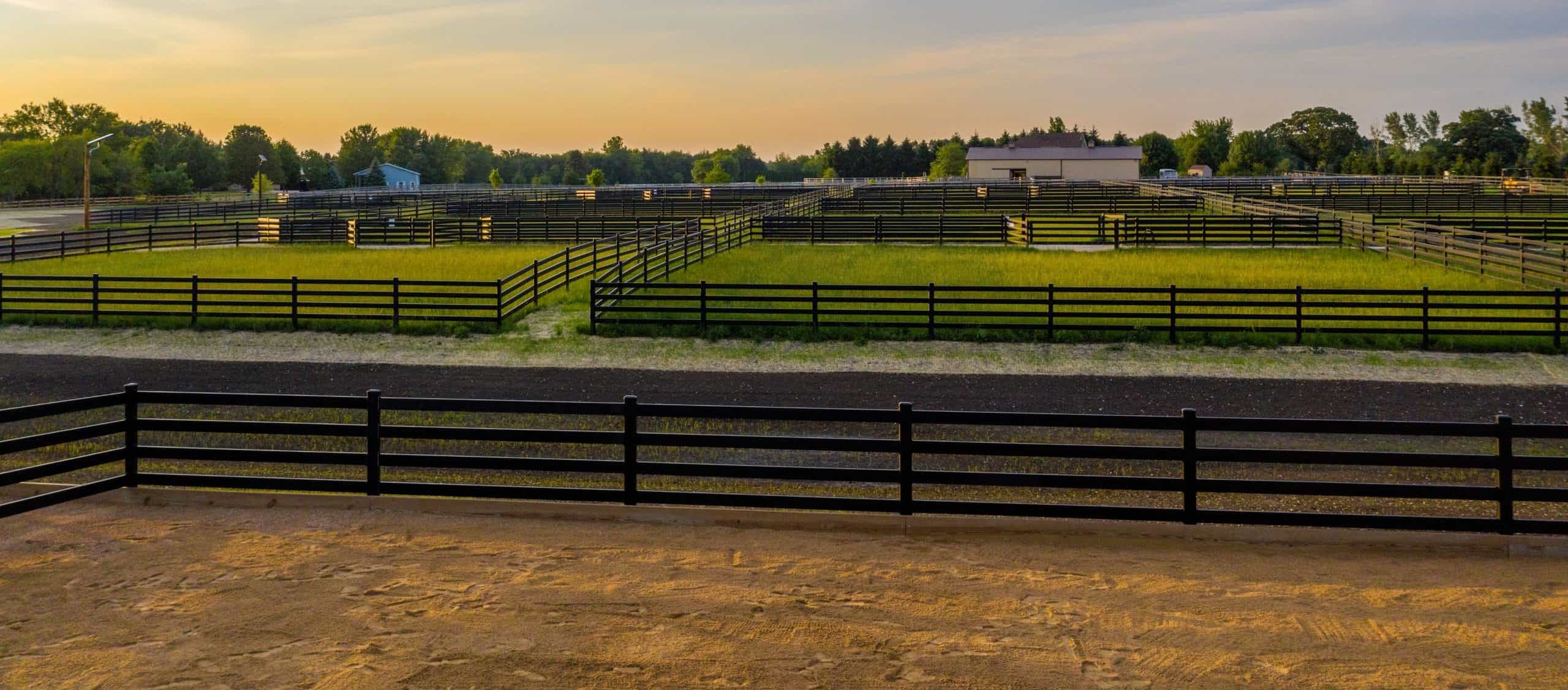Fencing isn’t just about marking property lines. It’s the difference between a good night’s sleep and a 2 AM call that your horses are on the neighbor’s property or your cattle have scattered across three counties.
Good fence design matters because it directly impacts what you care about most: the safety of your animals, the management of your land, and ultimately, the value of your property. Get it right, and your fence becomes an asset that pays dividends for decades. Get it wrong, and you’re throwing good money after bad with constant repairs and potential livestock losses.
Below, we’ll focus on what actually works in the real world. No theory, but proven fence designs that stand up to livestock pressure, harsh weather, and the test of time.
What Do We Mean by “Fence Design”?
When we talk about fence design, we’re not just referring to how a fence looks. Yes, that certainly matters for many properties, but we’re talking about the complete system that creates a functional boundary.
Fence design encompasses everything from the materials you select to the way those materials come together to serve a specific purpose. It’s the height of your fence, the spacing between posts, the number of rails or strands of wire, the type of bracing at corners, and even the gate placement that creates efficient flow for your operation.
Good fence design starts with understanding what you’re trying to accomplish. Are you containing animals that test boundaries? Keeping predators out? Creating separate paddocks for rotational grazing? Or maybe you need a combination of all these functions across different sections of your property.
We’ve walked thousands of acres with ranchers who thought they needed one type of fence only to realize their actual needs called for something entirely different. The cattle rancher who discovered his rocky terrain made traditional post installation nearly impossible. The horse property owner who needed both security and aesthetics where the fence lined the main road. The sheep farmer whose predator pressure required specialized design elements.
In our experience, the most successful fence designs are those that balance immediate needs with long-term considerations. That might mean spending more upfront for materials that will outlast cheaper options by decades, or incorporating flexibility into certain sections where your management practices might change.
The bottom line is this: thoughtful fence design prevents problems before they happen and creates infrastructure that improves your daily operations rather than creating maintenance headaches down the road.
Top Fence Designs for Horse Properties
Horse owners face unique challenges. These powerful, curious animals test boundaries differently than other livestock. They lean on fences, scratch against posts, and some seem to view your carefully installed boundary as nothing more than an interesting puzzle to solve. Add in their flight response when startled, and you quickly understand why horse-specific fence designs matter.
Here’s how the top fence designs compare for horse properties:
| Fence Design | Visibility | Safety | Durability | Maintenance | Cost | Best For |
| Post and Rail | Excellent | Very Good | Good-Excellent | Moderate-High | High | Show properties, breeding farms, high-visibility areas |
| Mesh and Wire | Moderate | Excellent | Excellent | Low | Moderate | Large pastures, security-focused operations |
| Hybrid Designs | Very Good | Excellent | Excellent | Low-Moderate | Moderate-High | Multi-use facilities, perimeters with public visibility |
| High-Tensile Wire | Poor-Moderate | Moderate | Excellent | Very Low | Low-Moderate | Large acreage, supplemental interior fencing |
| Pipe and Panel | Excellent | Excellent | Excellent | Very Low | Very High | Corrals, handling areas, stallion paddocks |
Each of these designs has its place on a horse property. Many successful operations use different fence designs for different areas. They might use post and rail along the driveway for aesthetics and transition to mesh fencing for larger pastures,with pipe panels in high-pressure areas like corrals.
1. Post and Rail
There’s a reason post and rail has been the gold standard for horse properties for generations. Nothing beats its visibility and classic appearance. When properly constructed with quality materials, these fences create clear boundaries that horses respect.
Traditional wood fences made of post and rail offers warmth and character but requires regular maintenance to prevent rot and chewing damage. Steel post and rail systems deliver the most strength and longevity while maintaining clean sightlines. Plus, they won’t rot, warp, or succumb to horse teeth. Modern vinyl fences and polymer alternatives deliver similar aesthetics with significantly reduced upkeep, though at a higher initial cost.
The key is proper post depth (at least 3 feet for stability), quality bracing at corners, and appropriate rail spacing. For horses, we recommend 3-4 rails with no more than 9 inches between them to prevent a horse from rolling under or getting caught between rails.
2. Mesh and Wire
Mesh and wire fence designs provide top-notch safety with lower maintenance demands. V-mesh and no-climb horse fences create a solid barrier without catch points where hooves can become trapped. The small openings prevent curious horses from getting legs caught, making these designs a good fit for foals and playful youngsters.
It all comes down to proper tensioning and secure attachment to sturdy posts. A sagging mesh fence loses both effectiveness and longevity. We recommend using treated wood or metal posts at 8-10 foot intervals. Adding a visible top rail helps horses see the boundary, especially in low light. While less traditional-looking than post and rail, these designs deliver safety and containment at a decent price point.
3. Hybrid Designs
Hybrid designs combine the visibility of rail systems with the safety of mesh or wire. Typically featuring a wood, steel, or vinyl top rail above no-climb wire or mesh, these fences give horses clear visual boundaries while providing protection against escape or injury.
These fence designs are great where aesthetics matter but budget constraints prevent full post-and-rail installation. The top rail provides immediate visual definition while reinforcing the fence against horse pressure. Many ranchers add a middle rail for additional strength and visibility. Steel rails paired with quality mesh create a nearly maintenance-free system that delivers decades of service.
4. Barbed Wire Systems
Barbed wire has no place on a dedicated horse property. We’ve seen too many injuries from horses encountering barbed wire to recommend it in any equine application.
While barbed wire remains economical for vast cattle operations, the risk to horses simply isn’t worth it. The combination of a horse’s thin skin, propensity for panic, and natural flight response makes barbed wire particularly dangerous. When startled, a horse can suffer severe lacerations that may end their riding career or worse.
If you run a mixed operation with both horses and cattle, we strongly recommend using safer alternatives for any areas where horses will be kept or might access during an escape.
5. High-Tensile Wire Fencing
High-tensile wire offers a compromise for horse properties. When properly installed with adequate visibility features, it can be a cost-effective option for perimeter fencing. The key is making it horse-safe through thoughtful design.
The wire’s strength comes from high carbon steel stretched to precise tension—around 200-250 pounds. This tension helps it absorb impact without breaking when horses test boundaries. For horse applications, visibility enhancements are non-negotiable: add polymer visibility strips, a top sight rail, or alternating tape with wire strands.
We always recommend rounded posts without sharp edges and secure connections that won’t create catch points. When budget constraints make mesh fencing impractical for large areas, a well-designed high-tensile system with proper visibility features offers a doable alternative.
6. Pipe and Cable-Heavy Designs
Steel pipe posts set in concrete with heavy-duty cables or rails create nearly indestructible boundaries. While the initial investment is substantial, these systems often outlast all other fencing options by decades with minimal maintenance. The smooth surfaces prevent injuries and the visible structure clearly communicates boundaries even to young or spirited horses.
For working facilities where animals are frequently handled, sorted, or confined, pipe fence systems provide the strength and safety that simply can’t be matched by other designs.
7. Field Fencing
Traditional field fencing (also called woven wire) occupies a middle ground between high-tensile wire and specialized horse mesh. With rectangular openings that gradually decrease in size toward the ground, field fencing provides reasonably good containment at a lower price point than horse-specific mesh products.
The larger openings at the top create potential catch hazards for horses, however, making a top rail necessary for safety. Quality matters tremendously, too. Cheap field fencing quickly sags, creating even greater safety concerns. We recommend 12.5-gauge minimum with proper tensioning equipment during installation.
This option works best for secondary paddocks or as an economical solution when paired with a visible top rail and middle rail. For primary horse paddocks (especially those housing valuable animals or young stock), the additional investment in proper horse mesh typically pays dividends.
8. Rotational Grazing Fence Systems
Rotational grazing systems require fence designs that balance flexibility with functionality. These systems let you maximize pasture health while minimizing parasite loads, but they demand a different approach to fencing.
For horses, semi-permanent electric tape or rope systems on fiberglass or step-in posts offer the ideal combination of visibility, portability, and effectiveness. However, you’ll need to think about energizer sizing—underpowered units create containment problems and training difficulties. We recommend at least 0.25 joules per acre of fence, with higher output for larger properties or multiple paddock divisions.
9. Property Perimeter Designs
For horse properties visible from main roads, consider investing in high-quality post and rail or hybrid designs for these sections, potentially transitioning to more economical options for less visible boundaries. Steel rail systems offer the perfect blend of durability and appearance for these high-visibility areas.
Security considerations should drive gate placement and design. Proper vehicle gates should be at least 16 feet wide to accommodate hay deliveries and equipment. Man gates should be strategically placed for movement during chores and emergencies. Remember that your perimeter design sets the tone for your entire property while providing the first line of security for valuable livestock.
Choose the Right Fencing Design for Your Operation
The right fence design balances your specific needs with long-term value. Most successful properties combine multiple designs: steel post and rail for visibility, quality mesh for larger areas, and specialized solutions for working facilities.
At Buckley Fence, our steel fence systems deliver classic aesthetics with unmatched durability. Whether you’re fencing 2 acres or 2,000, we build solutions that stand the test of time to protect what matters most long after cheaper alternatives have failed.
Send us a message today, and let’s talk about your fencing needs.



